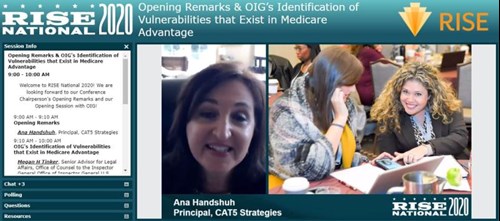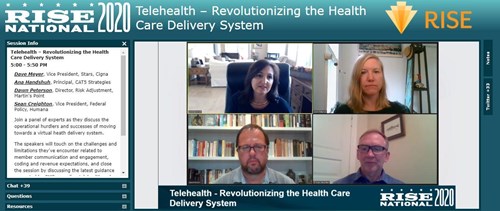Did you miss last month’s RISE National 2020 virtual conference? Here’s a summary of a few of the sessions.



OIG's work on vulnerabilities with Medicare Advantage
Megan Tinker, senior advisor for legal affairs, and San Le and Jacqualine Reid, both social science research analysts at the Office of Inspector General, gave an excellent presentation, providing attendees with the findings of recent evaluations and investigations aimed to ensure that beneficiaries of the Medicare Advantage (MA) program get the services they need and funds aren’t being diverted through fraud, waste, and abuse.
Essentially the OIG aims to root bad actors out of the system and ensure that the services provided lead to healthier people, lower costs, better care, and a more economic and efficient system. That mission permeates everything the OIG does, including how it identifies risks and where it spends its limited resources. OIG research focuses on three main buckets: quality (such as denials or appeals); federal money (fraud and RADV); and data (security, adequacy, and compliance). The presentation addressed OIG reports and recommendations on:
- MA appeal outcomes (MAOs overturned 75 percent of their own denials and 1 percent of denials were appeals during 2014-2016)
- Behavioral health provider shortages in New Mexico’s Medicaid Managed Care (75 of 218 enrollees had unsupported diagnoses codes due to ineffective policies and procedures to detect and correct noncompliance)
- Data security vulnerabilities (which found disparate treatment at the state and MCOs as well as an increased risk to Medicaid patient data)
- Office of Evaluation and Inspections (OEI) work related to MA encounter data:
- Chart reviews almost always added rather than deleted diagnoses for risk adjustment
- Increased estimated risk-adjusted payments from chart reviews far exceeded decreased payment
- Estimated payments from unlinked chart reviews totaled $2.7 billion–they weren’t linked to service records and many contained default procedure codes)
NCQA updates
We heard the latest plans from the National Committee for Quality Assurance regarding quality reporting and telehealth during and after COVID-19.
Paul Cotton, director of federal affairs for NCQA, said the pandemic has led the organization to move all activities virtual, including its health plan accreditation surveys. It has canceled Quality Compass and the release of 2020 plan ratings and Cotton said it will base the 2020 Health Plan Report Card on existing status or performance on 2020 standards. In addition, Medicare Advantage plans will not be required to report HEDIS data for measurement year 2019, and NCQA will not collect data for CAHPS.
RELATED: COVID-19 update: NCQA announces new HEDIS and CAHPS reporting policies
Meanwhile, the NCQA has plans to soon start a new interactive community for digital quality measurement and on Monday launched a taskforce on telehealth policy to identify the best ways to integrate telehealth into traditional care once we get past the COVID-19 public health crisis. The task force includes representatives from HHS, CMS, clinicians, consumers, telehealth firms, and health systems but also seeks public comments. Cotton said the task force plans to release its consensus recommendations by September.
The future of interoperability
Panelists shared challenges, improvements, and opportunities for continued expansion. The digitization of health care has established a foundation and electronic-based environment, but the progression toward interoperability has been slow due to several barriers, noted Chad Brooker, associate principal, policy, Avalere Health. Attendees were asked for direct feedback through an in-session polling question regarding the biggest payer/provider data sharing challenges. The leading barrier identified, according to 35 percent of responses, was a lack of data and measure standardization. The remaining challenges included:
- Integrity, quality, and timeliness of data shared (27 percent)
- A lack of trust between payers and providers (20 percent)
- A lack of technical interoperability (12 percent)
- None of the above (4 percent)
- Key information such as prior authorization requirements, benefits, eligibility not available (2 percent)
RELATED: COVID-19 update: NCQA announces new HEDIS and CAHPS reporting policies
Payer, provider, vendor collaboration
A session on how to improve risk and quality highlighted a successful collaboration between M Health Fairview, UCare, and Optum to improve quality and coding accuracy. Panelists shared the key components to their partnership that propelled improvement and growth for both payers and providers, including a tactical working group with representation from coding, medical records, population health, and quality and primary care to execute the strategy; accountability oversight assigned to Population Health Governance Committee; weekly status updates and meetings; and the development of an ongoing strategic approach.
In the session, provider/payer collaboration in a virtual world, presenters discussed the new realities in chart retrieval and lessons learned so far in telehealth. Panelists emphasized the importance of true collaboration between payers and providers for efficient access to charts, provider education, and telehealth. “Payers and providers weren’t natural friends,” said Rich Bitting, vice president, actuarial informatics, Jefferson Health. “But when you find the common ground where you can improve the patient experience, improve the member experience, and create a win all around, those are the scenarios that make the most sense.”
Shelley Collins, R.N., director of clinical quality improvement, Blue Cross and Blue Shield of Nebraska (BCBSNE) and Erica Krieger, vice president, quality, Advantasure, discussed the benefits of vendor/client partnerships for Star rating success. Their partnership began in October 2015 shortly after BCBSNE began to search for a MA partner to help prepare for the 2017 AEP. The insurer wanted to enter the MA market but knew its penetration would be low and it had limited inhouse capabilities. Advantasure offered consultative support, experience, multifaceted turnkey solutions, and a partnership based on upside and downside risk.
BCBSNE is a small plan but has seen incremental growth since its 2017 launch and expansion of its service area. It began with 500 members, increased to 1,500 in 2019, and has since doubled that membership to 3,000. Collins and Krieger said the partnership works well because the two organizations set clear expectations from the start, made sure communication is constant and transparent, collaborated by leveraging the strengths of each team, and engaged team members by working toward a common goal. The biggest piece may be intangible and involves relationship building, according to Krieger. Spending time together to better understand each other’s perspective. She also said respect is an important factor and giving people a realistic and reasonable amount of time to work through problems. “Not everything has to be a fire drill. Give people a realistic time to respond.”
The future of telehealth
The first day wrapped up with a panel discussion on telehealth and how it has revolutionized the health care delivery system. Discussion points included challenges for member communication and engagement and the latest guidance from the Centers for Medicare & Medicaid Services (CMS) for telehealth. Dave Meyer, vice president, risk adjustment, quality for Cigna, kicked off the discussion, noting that telehealth has been the bright spot in what otherwise has been a miserable year. Sean Creighton, vice president, federal policy for Humana, predicted that telehealth is here to stay, but it remains to be seen as to whether CMS will allow telehealth for Medicare risk adjustment.

Keynotes inspired: Underscored the importance of resiliency in times of trouble
RISE National featured three star-studded presentations on overcoming racism and poverty and finding strength under unimaginable emotional, physical, and mental circumstances. They all told stories of resiliency and the ability to pivot and give back to their communities.
John Quiñones, the ABC News veteran and creator and host of the highly rated hidden camera show, What Would You Do?, shared a heartfelt message about his own hardships as a child in poverty and the perseverance that allowed him to defy the odds to become an Emmy Award winning journalist. Quiñones showed a past episode of a woman reprimanding her foster child in the middle of a restaurant as well as snippets from the current season of What Would You Do? to illustrate what people do when confronted with an injustice and don’t know they are being watched…Do they step in or walk away? The timing of the new season couldn’t be better given the moral dilemmas we face today. For example, if you could prevent the spread of a deadly disease if you could simply wear a mask, do you do it? What would you do if you come face-to-face with racism or policy brutality? Would you join the protestors or criticize them? Quiñones, who has made a career on shining a light on and giving a voice to those who don’t have a voice, said his work has proven the power of the camera when it is used in the right way.
Celebrity Chef Jeff Henderson shared his life story of redemption as a convicted felon to celebrity chef, bestselling author, and public speaker. Henderson, who spent 10 years in a federal prison, credited his inspiring transformation to resilience, mental toughness, and the ability to never give up hope even in the darkest moments. “I always had this thought in my mind that one day I’m going to be in a position to help change the narrative in my family,” he said. “So as a young child, I always had that concept: if you can see it, you can be it.”
Next, we heard from executive coach and celebrated artist, Allison Massari, who shared her personal experiences as a burn victim from a devastating car accident 22 years ago. Fifty percent of her body was covered in second and third-degree burns, requiring two separate skin graft surgeries, pain medication at the highest doses possible, and 40 days in the hospital. But it was the compassion from the health care team in the burn unit who truly healed her, she said. “Compassion heals the places that medicine cannot touch."

